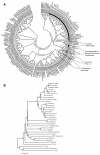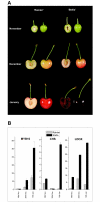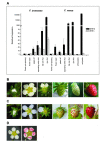An R2R3 MYB transcription factor associated with regulation of the anthocyanin biosynthetic pathway in Rosaceae
- PMID: 20302676
- PMCID: PMC2923524
- DOI: 10.1186/1471-2229-10-50
An R2R3 MYB transcription factor associated with regulation of the anthocyanin biosynthetic pathway in Rosaceae
Abstract
Background: The control of plant anthocyanin accumulation is via transcriptional regulation of the genes encoding the biosynthetic enzymes. A key activator appears to be an R2R3 MYB transcription factor. In apple fruit, skin anthocyanin levels are controlled by a gene called MYBA or MYB1, while the gene determining fruit flesh and foliage anthocyanin has been termed MYB10. In order to further understand tissue-specific anthocyanin regulation we have isolated orthologous MYB genes from all the commercially important rosaceous species.
Results: We use gene specific primers to show that the three MYB activators of apple anthocyanin (MYB10/MYB1/MYBA) are likely alleles of each other. MYB transcription factors, with high sequence identity to the apple gene were isolated from across the rosaceous family (e.g. apples, pears, plums, cherries, peaches, raspberries, rose, strawberry). Key identifying amino acid residues were found in both the DNA-binding and C-terminal domains of these MYBs. The expression of these MYB10 genes correlates with fruit and flower anthocyanin levels. Their function was tested in tobacco and strawberry. In tobacco, these MYBs were shown to induce the anthocyanin pathway when co-expressed with bHLHs, while over-expression of strawberry and apple genes in the crop of origin elevates anthocyanins.
Conclusions: This family-wide study of rosaceous R2R3 MYBs provides insight into the evolution of this plant trait. It has implications for the development of new coloured fruit and flowers, as well as aiding the understanding of temporal-spatial colour change.
Figures








Similar articles
-
An apple MYB transcription factor, MdMYB3, is involved in regulation of anthocyanin biosynthesis and flower development.BMC Plant Biol. 2013 Nov 7;13:176. doi: 10.1186/1471-2229-13-176. BMC Plant Biol. 2013. PMID: 24199943 Free PMC article.
-
Regulation of anthocyanin biosynthesis in peach fruits.Planta. 2014 Nov;240(5):913-29. doi: 10.1007/s00425-014-2078-2. Epub 2014 May 15. Planta. 2014. PMID: 24827911
-
A novel R2R3-MYB from grape hyacinth, MaMybA, which is different from MaAN2, confers intense and magenta anthocyanin pigmentation in tobacco.BMC Plant Biol. 2019 Sep 9;19(1):390. doi: 10.1186/s12870-019-1999-0. BMC Plant Biol. 2019. PMID: 31500571 Free PMC article.
-
Roles of R2R3-MYB transcription factors in transcriptional regulation of anthocyanin biosynthesis in horticultural plants.Plant Mol Biol. 2018 Sep;98(1-2):1-18. doi: 10.1007/s11103-018-0771-4. Epub 2018 Aug 30. Plant Mol Biol. 2018. PMID: 30167900 Review.
-
MYB transcription factors that colour our fruit.Trends Plant Sci. 2008 Mar;13(3):99-102. doi: 10.1016/j.tplants.2007.11.012. Epub 2008 Feb 14. Trends Plant Sci. 2008. PMID: 18280199 Review.
Cited by
-
Transcriptional regulation of flavonoid biosynthesis in nectarine (Prunus persica) by a set of R2R3 MYB transcription factors.BMC Plant Biol. 2013 Apr 25;13:68. doi: 10.1186/1471-2229-13-68. BMC Plant Biol. 2013. PMID: 23617716 Free PMC article.
-
Anthocyanin synthesis in orange carrot cv. Danvers is activated by transgene expression of the transcription factors DcMYB113_NB and DcEGL1_NB from black carrot cv. Nightbird.Plant Mol Biol. 2021 Jun;106(3):259-270. doi: 10.1007/s11103-021-01141-z. Epub 2021 Apr 9. Plant Mol Biol. 2021. PMID: 33837502
-
Metabolic and gene expression analysis of apple (Malus x domestica) carotenogenesis.J Exp Bot. 2012 Jul;63(12):4497-511. doi: 10.1093/jxb/ers134. Epub 2012 Jun 19. J Exp Bot. 2012. PMID: 22717407 Free PMC article.
-
MYB transcription factors-master regulators of phenylpropanoid biosynthesis and diverse developmental and stress responses.Plant Cell Rep. 2022 Dec;41(12):2245-2260. doi: 10.1007/s00299-022-02927-1. Epub 2022 Sep 29. Plant Cell Rep. 2022. PMID: 36171500 Review.
-
Allelic Variation of MYB10 Is the Major Force Controlling Natural Variation in Skin and Flesh Color in Strawberry (Fragaria spp.) Fruit.Plant Cell. 2020 Dec;32(12):3723-3749. doi: 10.1105/tpc.20.00474. Epub 2020 Sep 30. Plant Cell. 2020. PMID: 33004617 Free PMC article.
References
-
- Schaefer HM, Schaefer V, Levey DJ. How plant-animal interactions signal new insights in communication. Trends in Ecology & Evolution. 2004;19(11):577. doi: 10.1016/j.tree.2004.08.003. - DOI
Publication types
MeSH terms
Substances
LinkOut - more resources
Full Text Sources
Other Literature Sources

